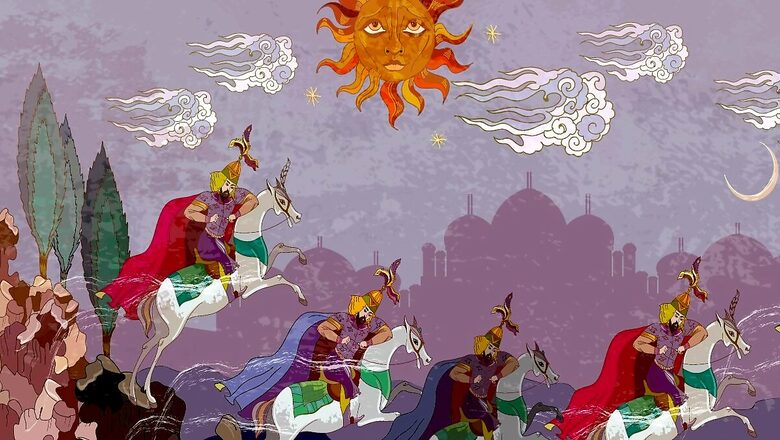
views
When the National Council of Educational Research and Training (NCERT) announced its decision to remove a chapter on the Mughal Empire from Class XII history textbooks, it predictably created a political storm. The Mughals are, after all, the sacred cow of Marxist-Nehruvian historiography.
There have been concerted attempts since the 1960s, when Indian history was hijacked by communist historians with the consent and connivance of their political masters, to rewrite textbooks to forward government agenda and Marxist dogma. The worst hit was India’s medieval history that had to be sanitised of all its inconvenient truths, but it was too tough a task to accomplish. This was primarily because the Muslim chroniclers of the medieval era pompously and matter-of-factly wrote in detail about each and every ‘iconoclastic’ exploits of their rulers. They saw these acts of violence and vandalism as a holy work that had the sanction of God.
This is where the presence of the Mughals, thanks primarily to Akbar’s liberal outlook, comes in handy for eminent historians in the benevolent projection of Muslim rule in India. The Mughals have become the face of Muslim rule in India. Once this cover is dropped, what comes out is the violent and vandalistic face of the medieval Muslim rulers. This explains the secular anxiety over NCERT’s decision to remove a Mughal chapter.
Actually, the Mughals have been the pet Marxist project in independent India. It had Akbar, who perfectly fitted the secular bill of Nehruvian India. He was the ‘Muslim’ counterpart of ‘Hindu’ Ashoka, though the latter was not a Hindu in a purely religious sense. He was a Buddhist who broke with the Sanatana tradition to put in place a state religion. Not an ideal ruler from the Indic civilisational perspective, he was lost in the annals of history until being accidentally discovered by James Prinsep in 1815. Ashoka’s greatness — again a byproduct of the Nehruvian project, if historian Upinder Singh is to be believed — is as much the result of Marxist deception as the notion of Mughal liberalism is.
Ashoka’s choice is a masterstroke for another reason too. A couple of years ago, senior journalist Karan Thapar came out strongly against Yogi Adityanath’s statement that the Mughals were not his heroes. Defending the Mughals, Thapar invoked Ashoka and Akbar. “I know many consider the Mauryan emperor Ashoka, who ruled 18 centuries earlier, Akbar’s equal or, possibly, heroically superior but I disagree. Akbar was not responsible for 100,000 deaths at Kalinga,” the eminent journalist said.
This line of argument is not accidental. This has always been the plan: To make Ashoka “the Great”, and then, in another context, bring out Kalinga to compare him with Akbar: “Look, Ashoka was good, don’t forget the Kalinga blemish!” The result: There was no great ruler in India before Akbar! What is generally forgotten in the enthusiastic support for Akbar is that for every Kalinga for Ashoka, there is a Ranthambore for Akbar where at least 30,000 non-combatant civilians were massacred after the Mughal victory. Even the much bandied about matrimonial alliances, largely with Rajput rulers, were one-way traffic and to look for religious syncretism in the Mughal harem would be an elusive affair.
Coming back to the NCERT controversy, it needs to be reiterated that the Mughals have not been dropped altogether from the textbooks; there were two chapters on them, of which one has been removed as part of NCERT’s “syllabus rationalisation” exercise. Now, that’s not a crime in a country where most mainstream history books gloss over the history of Ahoms and their 600-year rule that included the great Lachit Borphukan decisively defeating the Mughals at the Battle of Saraighat in 1671 during Aurangzeb’s time. Why should it bother dropping a chapter on Mughals when all the great empires of south India, especially the Cholas, are clubbed in one chapter? The Cholas and the Pallavas played a big role not just in the history of India but also in Southeast Asia. Why should it bother when Baji Rao-I has been reduced to a ‘lover boy’ in connection with the Mastani saga, while the reality is he was one of the finest generals India had seen, fighting over 40 battles without losing any? It was primarily due to his military exploits that the British took over India from the Marathas, and not the Mughals. When the Vijayanagara Empire is mentioned in passing in history books, why should the ongoing Mughal controversy bother us?
While the biggest historical fraud has been committed by the Marxists in ancient India, in the name of the Aryan invasion theory, equally dubious has been their role in medieval history, which seems episodic in nature, randomly jumping from Mohammed bin Qasim’s Sindh attack in 712 AD to Mahmud of Ghazni’s raids in the early 11th century, climaxing in the plunder of the Somnath temple in 1025 AD — and, then, the invasion of Mohammed Ghori in 1191 and again 1192. India’s history becomes all about invasions and invaders. Even colonial historian Vincent Smith could see through the fallacy of this kind of historiography when he writes in The Oxford History of India: “…But no voice has come from the grave, and the history of the Muhammadan conquest as seen from the Hindu point of view was never written, except to some extent in Rajputana.”
The truth is that it took almost 500 years for a Muslim Sultanate to get a foothold in Delhi. And, as Sandeep Balakrishna writes in his book Invaders and Infidels, “For almost a full century after it was established, the Sultanate made no new additions to its territory in mainland India”. Balakrishna continues, “From 1206 to 1526, it comprised a total of five dynasties, with only one powerful sultan emerging from each dynasty… Each such dynasty inevitably became extinct within a few years of the death of its most powerful sultan.”
The same phenomenon was perceptible during the Mughal era too when the ‘empire’ looked shaky till Akbar pursued liberal policies vis-à-vis Hindus and made matrimonial alliances with the Rajputs. Looked at closely, the two moves would appear strategic in nature, but the moment the later Mughals, especially Aurangzeb, went back to the old Islamic ways, the empire collapsed like a pack of cards. Aurangzeb died in 1707 AD and within 50 years the Mughal ‘empire’ found itself confined to the area from “Delhi to Palam”!
The NCERT controversy has brought the focus back to the manner in which Indian history is skewed against the civilisational idea of India. Largely Delhi-centric, Indian history should include narratives from other parts of the country. Those bemoaning the dropping of a chapter on the Mughals should reflect upon this hypocrisy, and call for Indian history to be told from India’s own perspective.
The author is Opinion Editor, Firstpost and News18. He tweets from @Utpal_Kumar1. Views expressed are personal.
Read all the Latest Opinions here
















Comments
0 comment